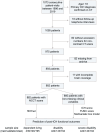Deep learning survival model predicts outcome after intracerebral hemorrhage from initial CT scan
- PMID: 38880882
- PMCID: PMC11569453
- DOI: 10.1177/23969873241260154
Deep learning survival model predicts outcome after intracerebral hemorrhage from initial CT scan
Abstract
Background: Predicting functional impairment after intracerebral hemorrhage (ICH) provides valuable information for planning of patient care and rehabilitation strategies. Current prognostic tools are limited in making long term predictions and require multiple expert-defined inputs and interpretation that make their clinical implementation challenging. This study aimed to predict long term functional impairment of ICH patients from admission non-contrast CT scans, leveraging deep learning models in a survival analysis framework.
Methods: We used the admission non-contrast CT scans from 882 patients from the Massachusetts General Hospital ICH Study for training, hyperparameter optimization, and model selection, and 146 patients from the Yale New Haven ICH Study for external validation of a deep learning model predicting functional outcome. Disability (modified Rankin scale [mRS] > 2), severe disability (mRS > 4), and dependent living status were assessed via telephone interviews after 6, 12, and 24 months. The prediction methods were evaluated by the c-index and compared with ICH score and FUNC score.
Results: Using non-contrast CT, our deep learning model achieved higher prediction accuracy of post-ICH dependent living, disability, and severe disability by 6, 12, and 24 months (c-index 0.742 [95% CI -0.700 to 0.778], 0.712 [95% CI -0.674 to 0.752], 0.779 [95% CI -0.733 to 0.832] respectively) compared with the ICH score (c-index 0.673 [95% CI -0.662 to 0.688], 0.647 [95% CI -0.637 to 0.661] and 0.697 [95% CI -0.675 to 0.717]) and FUNC score (c-index 0.701 [95% CI- 0.698 to 0.723], 0.668 [95% CI -0.657 to 0.680] and 0.727 [95% CI -0.708 to 0.753]). In the external independent Yale-ICH cohort, similar performance metrics were obtained for disability and severe disability (c-index 0.725 [95% CI -0.673 to 0.781] and 0.747 [95% CI -0.676 to 0.807], respectively). Similar AUC of predicting each outcome at 6 months, 1 and 2 years after ICH was achieved compared with ICH score and FUNC score.
Conclusion: We developed a generalizable deep learning model to predict onset of dependent living and disability after ICH, which could help to guide treatment decisions, advise relatives in the acute setting, optimize rehabilitation strategies, and anticipate long-term care needs.
Keywords: CT; deep learning; intracerebral hemorrhage; survival model.
Conflict of interest statement
Declaration of conflicting interestThe author(s) declared the following potential conflicts of interest with respect to the research, authorship, and/or publication of this article: J.R. reports compensation from National Football League for expert witness services from Takeda Development Center Americas and Boehringer Ingelheim for consultant services, all unrelated to this work. C.D.A. has received sponsored research support from Bayer AG and has consulted for ApoPharma unrelated to this work. E.M. is now a full-time employee of Regeneron Pharmaceuticals.
Figures





References
-
- Benjamin EJ, Muntner P, Alonso A, et al.. Heart disease and stroke statistics-2019 update: a report from the American Heart Association. Circulation 2019; 139: e56–e528. - PubMed
-
- Fernando SM, Qureshi D, Talarico R, et al. Intracerebral hemorrhage incidence, mortality, and association with oral anticoagulation use. Stroke 2021; 52: 1673–1681. - PubMed
-
- Katrak PH, Black D, Peeva V. Do stroke patients with intracerebral hemorrhage have a better functional outcome than patients with cerebral infarction? PM R 2009; 1: 427–433. - PubMed
-
- Hemphill JC, Bonovich DC, Besmertis L, et al. The ICH Score. Stroke 2001; 32: 891–897. - PubMed
MeSH terms
Grants and funding
LinkOut - more resources
Full Text Sources
Medical

